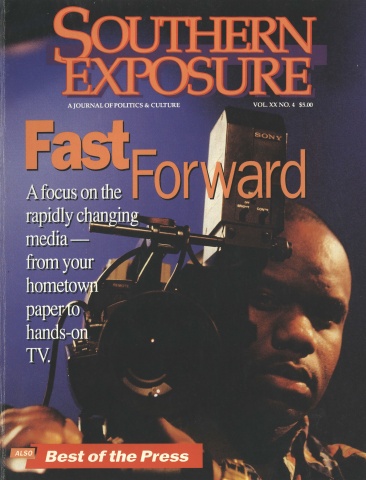Hurricanes

This article originally appeared in Southern Exposure Vol. 20 No. 4, "Fast Forward." Find more from that issue here.
Caribbean islanders called them evil spirits. Mayans worshiped Hunraken, the storm god. The National Weather Service prefers “Andrew” or “Bob.” Whatever the name, people living in the Southern regions have long feared and revered the hurricane.
Throughout history the South has been blasted by the furious storms. As early as 1667, English settlers in Jamestown recorded a “dreadful Hurry Cane” of “such violence that it overturned many houses, burying in the ruins much goods and many people.”
In the past century, 141 of the 148 hurricanes that hit the eastern United States swept through the South. Florida and Texas, with their long coastlines, have suffered the most. Fifty-three hurricanes have struck the Sunshine State since 1900, and 34 have pounded Texas.
Although hurricanes are not uniquely Southern, they are born in the warm waters of the deep tropics. “The further south you go, the better the chance you’re going to run into one,” says meteorologist Jack Beven of the National Hurricane Center.
The storms originate, explains Beven, when winds of tropical thunderstorms above 35,000 feet reach a certain speed — strong enough to blow upwards through the storm, yet light enough to remain around the low-pressure center, or eye, without shearing off. The result is a chimney-shaped storm with winds of more than 74 miles per hour. The average North Atlantic hurricane lasts eight days, and the hurricane “season” runs from June to October.
The South has borne the brunt of some of the nation’s worst hurricanes. In 1900 one of the violent storms leveled Galveston, Texas with 20-foot waves. About a third of the town’s residents — 6,000 people — were killed. A 1933 hurricane left 40 people dead and destroyed $12 million of property in Brownsville, Texas.
Winds of 200 miles an hour were recorded for Hurricane Camille, which cut a devastating swath through Mississippi, Louisiana, and Alabama in 1969. The storm killed 144 people and left 500 miles of road impassable.
Such ferocious natural history has also inspired regional writers. In Their Eyes Were Watching God, Zora Neale Hurston describes the helplessness of Florida migrant workers unable to escape a 1928 hurricane that their wealthier neighbors fled: “If the castles thought themselves secure, the cabins needn’t worry. Their decision was already made as always. Chink up your cracks, shiver in your wet beds and wait on the mercy of the Lord.” The hurricane broke dikes around Lake Okeechobee, flooding migrant communities and drowning 2,000 people.
Although modern-day hurricanes destroy the homes of rich and poor alike, folks of lesser means have a harder time escaping the storms — and recovering from the damage. “People who have money get into a mad scramble to find some kind of temporary housing,” says Don Cameron, a member of the Disaster Task Force that is still cleaning up Charleston, South Carolina three years after Hurricane Hugo. “Poor people don’t have that luxury because they generally don’t have transportation, they don’t know where to look, they don’t know how to look.”
When Hurricane Andrew leveled southern Florida last August, most of the 85,000 homes that were damaged or destroyed were occupied by people of low or moderate incomes. Four months later, many homes were still covered with plastic tarps, and debris remained piled on street corners. The insured damage is estimated at over $10 billion, a record for a natural disaster.
“There are people who are living in homes that are destroyed, with no roofs, open walls, no power,” says Gus Dominguez, assistant director of an affordable housing organization called Greater Miami Neighborhoods. “It’ll take years to rebuild.”
Perhaps the most distinctive feature of any hurricane is the fear it produces. Don Cameron stayed in his house with his wife and children during Hugo, but if another hurricane came, he says he would send them elsewhere.
“It’s a really traumatic situation,” he says. “It was like freight trains — it was awful.”
Tags
Mary Lee Kerr
Mary Lee Kerr is a freelance writer and editor who lives in Chapel Hill, NC. (2000)
Mary Lee Kerr writes “Still the South” from Carrboro, North Carolina. (1999)